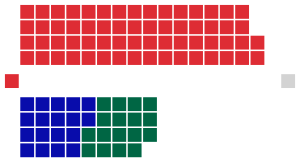New South Wales state election, 1978
| | ||||||||||||||||||||||||||||||||||||||||||||
| ||||||||||||||||||||||||||||||||||||||||||||
| ||||||||||||||||||||||||||||||||||||||||||||
|
| ||||||||||||||||||||||||||||||||||||||||||||
| Legislative Assembly after the election | ||||||||||||||||||||||||||||||||||||||||||||
| ||||||||||||||||||||||||||||||||||||||||||||
A general election was held in the state of New South Wales, Australia, on Saturday 7 October 1978. The result was a landslide victory for the Australian Labor Party under Neville Wran, popularly known as the "Wranslide."
It is notable for being so successful for the Labor Party that it tallied 57 percent of the primary vote, the largest primary vote for any party in over a century. Having gone into the election with a razor-thin majority of one seat, Labor scored a 13-seat swing, giving it a strong majority of 63 seats. Labor even managed to defeat the Leader of the Opposition, Peter Coleman, in his own electorate. The seats of many other prominent Shadow Ministers fell to Labor as well. Labor also won took many seats in areas long reckoned as Coalition heartland. Among them were four seats that Labor had never won before this election--Willoughby (contested for the Liberal Party by Nick Greiner who later became Premier), Manly, Wakehurst and Cronulla.
The state's first elections to the New South Wales Legislative Council, the state parliament's upper house, were held simultaneously. Voters had approved a referendum to introduce a directly elected council in June of that year.
The election was also the first in the state to be contested by the Australian Democrats.
Labor continued to campaign heavily on the strengths of Wran himself, with the slogan "Wran's our man".
Key dates
| Date | Event |
|---|---|
| 12 September 1978 | The Legislative Assembly was dissolved, and writs were issued by the Governor to proceed with an election.[1] |
| 18 September 1978 | Nominations for candidates for the election closed at noon. |
| 7 October 1978 | Polling day, between the hours of 8am and 6pm. |
| 19 October 1978 | The second Wran ministry was constituted. |
| 3 November 1978 | The writ was returned and the results formally declared. |
| 7 November 1978 | Parliament resumed for business. |
Results
Legislative Assembly
|
New South Wales state election, 7 October 1978[2][3] | ||||||
|---|---|---|---|---|---|---|
| Enrolled voters | 3,085,661 | |||||
| Votes cast | 2,862,616 | Turnout | 92.77 | –0.52 | ||
| Informal votes | 65,274 | Informal | 2.28 | +0.52 | ||
| Summary of votes by party | ||||||
| Party | Primary votes | % | Swing | Seats | Change | |
| Labor | 1,615,949 | 57.77 | +8.02 | 63 | +13 | |
| Liberal | 754,796 | 26.98 | –9.31 | 18 | –12 | |
| National Country | 276,984 | 9.90 | –0.13 | 17 | – 1 | |
| Democrats | 74,019 | 2.65 | +2.65 | 0 | ± 0 | |
| Communist | 8,472 | 0.30 | +0.22 | 0 | ± 0 | |
| Socialist Workers | 4,467 | 0.16 | +0.07 | 0 | ± 0 | |
| Independent | 62,655 | 2.24 | –0.58 | 1 | ± 0 | |
| Total | 2,797,342 | 99 | ||||
Legislative Council
|
New South Wales state election, 7 October 1978[4] | ||||||
|---|---|---|---|---|---|---|
| Enrolled voters | 3,085,661 | |||||
| Votes cast | 2,862,616 | Turnout | 92.77 | |||
| Informal votes | 115,995 | Informal | 4.05 | |||
| Summary of votes by party | ||||||
| Party | Primary votes | % | Swing | Seats won |
Seats held | |
| Labor | 1,508,078 | 54.91 | 9 | 23 | ||
| Liberal/National Coalition | 996,463 | 36.28 | 6 | 20 | ||
| Democrats | 76,369 | 2.78 | 0 | |||
| Communist | 79,794 | 2.91 | 0 | |||
| Family Action Movement | 36,076 | 1.31 | 0 | |||
| Marijuana | 25,055 | 0.91 | 0 | |||
| Independent | 24,786 | 0.90 | 0 | |||
| Total | 2,746,621 | 15 | ||||
The final 2 party preferred result was 60.7% for Labor and 39.3% for the Coalition, making it one of the biggest landslide victories in New South Wales's electoral history. In 2PP terms it was a 9.1% swing to Labor from the Coalition. This was beaten by the Coalition's result of 64.2% and 35.8% for Labor in the 2011 election. However, Labor's record primary vote of 57.7 percent still stands today.
Post-election pendulum
See also
Notes
- ↑ Parliament of New South Wales. "1978 Election". Retrieved 6 February 2010.
- ↑ Australian Government and Politics Database. "Parliament of New South Wales, Assembly election, 7 October 1978". Retrieved 6 February 2010.
- ↑ Hughes, Colin A. (1986). A handbook of Australian government and politics, 1975-1984. ANU Press. p. 191. ISBN 0-08-033038-X.
- ↑ Hughes (1986), p.192.
.jpg)

